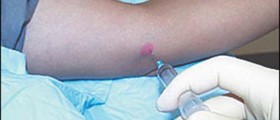
Progesterone
Progesterone is in charge for the female regulation of menstruation and ovulation period. And progesterone can be induced to stimulate menstrual periods in women if there is a decrease of progesterone or to control overgrowth in uterus lining for women who are on the estrogen hormone replacement therapy. In women progesterone levels are relatively low during the preovulatory phase of the period higher after ovulation and elevated during the luteal phase.
Progesterone levels tend to be < 2 ng/ml prior to ovulation and > 5 ng/ml after ovulation. With pregnant women, progesterone levels are initially maintained at luteal levels. The luteal-placental shift in progesterone support of the pregnancy and levels start to increase further and may reach 100-200 ng/ml. If the decrease in progesterone levels is critical and labor is on the way it may be species-specific because after placenta delivery and during lactation progesterone levels are very low.
Progesterone has other purposes but it is dangerous to use without consulting the doctor especially if the woman is pregnant because it can damage the baby. Such medications may have peanut oil and peanut allergy do not go well with progesterone due to a possibility to risk of having a breast cancer, stroke, blood clots, heart attack etc.
Progesterone is not to be used in cases of:
heart attack, blood clot, liver disease, breast cancer, abnormal vaginal bleeding, a stroke heart disease dementiaProgesterone Side Effects Classified by Body System
Cardiovascular side effects are angina pectoris, syncope, chest pain, palpitations and hypertension.
Gastrointestinal side effects are constipation, abdominal pain, diarrhea, bloating, dyspepsia, nausea, dry mouth, hemorrhagic rectum, gastroenteritis, vomiting, hiatus hernia etc.
Musculoskeletal side effects are musculoskeletal pain, joint pain, back pain, arthritis, myalgia, hypertonia, muscle disorder and leg cramps.
Dermatologic side effects are acne, verruca, rash, pruritus, seborrhea, wound debridement, autoimmune dermatitis and skin discoloration.
Respiratory side effects are pharyngitis, cough, bronchitis, pneumonitis, sinusitis and nasal congestion.
Hepatic side effects are reversible hepatitis, cholecystectomy ad nelevated transaminases.
Ocular side effect is abnormal vision.
Immunologic side effect is autoimmune dermatitis due to a luteal phase of women period.
Genitourinary side effects are urinary problems, breast tenderness, vaginal discharge, breast, breast carcinoma pain, vaginal dryness, breast excisional biopsy (2%), leukorrhea, uterine fibroid, breast enlargement, fungal vaginitis, vaginal dryness, cystitis, dysuria, urinary tract infection vaginitis etc...
Psychiatric side effects are insomnia, depression, impaired concentration, anxiety, personality disorder etc.
Nervous system side effects are confusion, dizziness, headache (31%), (15%), asthenia, somnolence, nervousness, increased sweating, speech disorder tremor, migraine and syncope with and without hypotension.
Local side effects are pain, redness and irritation.
Other side effects are irritability, viral infection, fatigue, hot flashes, night sweats, anorexia, tooth disorder, more appetite, peripheral edema, accidental injury, fever, lymphadenopathy, herpes simplex and abscess.






-Why-Some-Women-Take-This-Type-Of-Progesterone-During-Early-Pregnancy_f_280x120.jpg)









Your thoughts on this
Loading...